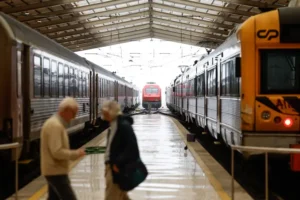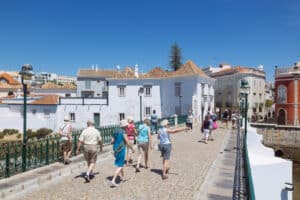High-speed rail link to Vigo is considered a “priority”
After a brief meeting with the president of the regional government of Galicia, Portugal’s minister of infrastructure said that the government was still committed to the high-speed rail link between Lisbon and Vigo, as well as to Madrid.
According to the minister for infrastructure and housing, Miguel Pinto Luz, it was clear from a working meeting with “the Galician regional government” that “the priority that existed” under the previous government, the Lisbon-Vigo high-speed link, “remains”, and that, as the government announced a few days ago, it will add to this investment the need to start “the Lisbon-Madrid link”.
“This priority is absolutely clear to the Portuguese government (…), which is the two hours that will preferably connect Lisbon to Vigo and, later, Lisbon-Madrid in three hours and, therefore, the Iberian Peninsula will certainly be a more cohesive, closer space,” said Pinto Luz.
The Portuguese minister was speaking at the Ministry of Infrastructure and Housing in Lisbon, after a brief meeting with Alfonso Rueda, president of the Galicia regional government (or Xunta de Galicia, in Galician).
“But here’s a special mention for Galicia, a special relationship, in fact, that the country has with this much more permeable border to the north,” he emphasised.
The minister stressed that the public-private partnerships (PPP) for the high-speed connection on the Portuguese side “are scheduled” since the previous government “had already signalled” them, and the current government led by Luís Montenegro reaffirms “this commitment”, assuming that there has to be “this symbiotic character on both sides”.
“We have the conditions to guarantee that the two sides will be aligned in terms of deadlines so that we don’t have the work ready on one side of the border and then not ready on the other side and, therefore, both the Lisbon-Madrid and Lisbon-Vigo timetables are absolutely linked,” assured Miguel Pinto Luz, noting that “these are projects for generations”.
Regarding the railway gauge adopted for the high-speed link, the minister said that the government was calm and that “Portugal and Spain are aligned“.
“We’re doing it on Iberian gauge (…), so Spain has the work underway on Iberian gauge, and Portugal will do it on the same gauge as Spain,” replied Pinto Luz, adding that the two governments are “absolutely interconnected in the decision and in due course, the whole infrastructure is being prepared so that there can be a migration at the right time and this is being negotiated with the European Commission.”
When asked about possible improvements to the current rail link between the two Iberian capitals, he emphasised that “Lisbon-Madrid is a phased project” and the TGV won’t be operational until 2034, but until then he promised to “improve all the services on offer”.
“We’ll have an increasingly better connection throughout this decade to enable this Lisbon-Madrid link, so it won’t be until 2034 that […] we’ll be able to go with quality between Lisbon and Madrid, in 2034 we’ll be able to go faster,” emphasised Pinto Luz, without giving details of the investments, but guaranteeing that by then there will be an “improvement in this service” and that this “is a gradual and absolutely fundamental process”.
The president of the Xunta de Galicia explained that the meeting served to “get to know first-hand the head of Infrastructures of the Portuguese government” about the “prospects for the implementation of an infrastructure” that, for Portugal and certainly for Galicia “is absolutely fundamental”.
In view of the Portuguese government’s announcement to build the link between Lisbon and Madrid, which Galicia “has absolutely nothing to object to”, Alfonso Rueda Valenzuela wanted to know if there could be “a delay, a postponement of the implementation of infrastructure that is “absolutely fundamental” for Galicia”.
This is because, he emphasised, the “Galicia-Northern Portugal Euro region” is “by far the cross-border territory between Spain and Portugal where most exchanges of all kinds take place, of an economic nature, the movement of workers“, and everything that “has involved a very fluid relationship for many years between Galicia and Northern Portugal”.
“I leave this meeting very calm, very satisfied. The minister confirmed to us that the Portuguese government maintains its intention to implement this infrastructure, including very specific deadlines,” acknowledged Alfonso Rueda, considering, however, that “every month that passes is essential” for the date set by the Portuguese government to reach the border with Spain.
The Lisbon-Porto high-speed line should connect the country’s two main cities in an hour and 15 minutes, with possible stops in Gaia, Aveiro, Coimbra and Leiria. The Porto – Vigo route is estimated to take 50 minutes.
The first phase (Porto—Soure) of the high-speed line in Portugal should be ready in 2030. The second phase (Soure—Carregado) is scheduled for completion in 2032. It will connect Lisbon via the Northern Line.
The public tender for lot 1 (Porto-Oiã) of the first phase was launched in January, and lot two (Oiã-Soure) should be launched in July. The connection to Lisbon will go ahead in 2026.
The connection from Porto to Vigo, in Galicia (Spain), is scheduled for after 2030 and will have stations at Francisco Sá Carneiro Airport, Braga, Ponte de Lima and Valença (Viana do Castelo district).
According to the previous government, the investment costs for the Lisbon-Valença axis total around seven to eight billion euros.
Source: LUSA


























